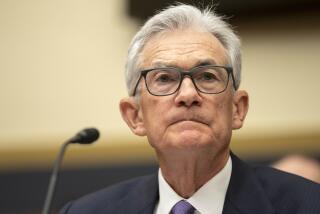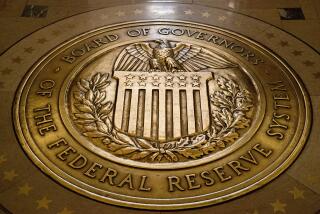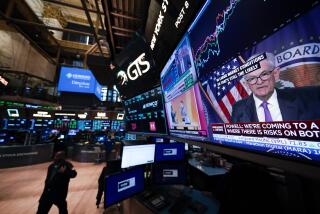Fed nears end of stimulus but stays vague on interest rate hike timing
Federal Reserve policymakers took the next-to-last step in ending their controversial bond-buying stimulus program as the economy continues to heal.
But they offered no new hints on how soon the Fed would once again hike interest rates — after nearly six years of keeping rates near zero percent.
As investors and analysts await word, Fed officials Wednesday reaffirmed they were keeping the central bank’s benchmark short-term interest rate near zero and probably would for “a considerable time” after the bond purchases end next month.
As the nation’s unemployment rate continues to fall, there has been growing pressure on the Fed to raise rates or at least be more specific about when it will. A rate hike would prevent the continued flow of low-interest money from possibly triggering high inflation.
At her quarterly news conference afterward, Fed Chairwoman Janet L. Yellen said the so-called forward guidance about interest rates was not intended to be “a firm promise about a particular amount of time.”
Instead, she said, it was a vague statement by her and the other policymakers on the Federal Open Market Committee to provide for flexibility if economic conditions change.
“I know ‘considerable time’ sounds like it’s a calendar concept, but it is highly conditional and it’s linked to the committee’s assessment of the economy,” she said. “They want to make sure that if progress really does turn out to be faster than we would expect, that the committee will be in a position to start sooner, tightening monetary policy.”
In their official predictions, most Fed policymakers anticipate the central bank will start raising interest rates in 2015.
Analysts expect such a move around the middle of next year. On Wednesday, the Fed issued new details about the complex mechanics it plans to use to raise interest rates when the time comes.
But frustration is rising inside and outside the Fed with the lack of specifics about that timing.
After a two-day policy meeting this week, two of the 10 voting members of the committee dissented on the statement because of the wording. Only one committee member dissented from the statement in June, which also stressed interest rates would remain low for a “considerable time” after the bond-buying program ended.
Charles Plosser, president of the Federal Reserve Bank of Philadelphia, dissented in June and did so again Wednesday for the same reason. He said the guidance was “time dependent and does not reflect the considerable economic progress that has been made toward the committee’s goals,” according to the Fed’s statement.
He was joined by Richard Fisher, president of the Federal Reserve Bank of Dallas. He dissented because he believed continued improvement in the economy and labor market “likely warrant an earlier reduction in monetary accommodation than is suggested by the committee’s forward guidance,” the Fed statement said.
In its statement, the Fed was “tiptoeing around the obvious,” said Bernard Baumohl, chief global economist at the Economic Outlook Group.
“Let’s get real here. The Fed’s zero-interest-rate policy will formally end around the middle of next year, a move already widely anticipated by the financial markets and business leaders,” he said. “So we think the Federal Reserve is being overly cautious, even silly, for the tortuous manner it sometimes crafts the FOMC statement.”
Yellen downplayed the dissents even as fresh evidence Wednesday that inflation remained tame bolstered her case for waiting on rate hikes.
“I think it’s very natural that the committee should have a range of opinion about a decision as crucial as what is the right time to begin to normalize policy,” she said. “I don’t consider two dissents to be an abnormally large number.”
In an overview, the Fed said the economy has been expanding “at a moderate pace,” but policymakers slightly downgraded their economic projections for this year and 2015.
The Fed now forecasts the economy will grow 2% to 2.2% this year compared with a June forecast of 2.1% to 2.3%. In 2015, the Fed forecasts the economy will expand 2.6% to 3%. In June, the 2015 forecast was for growth of 3% to 3.2%.
Despite those projections, the Fed thinks the unemployment rate will fall a bit faster than it forecast in June. The rate, which was 6.1% in August, now could go as low as 5.9% by the end of this year and 5.4% in 2015.
With the labor market continuing to improve, the Fed voted Wednesday to reduce its monthly bond buying by another $10 billion in October.
The Fed will buy just $15 billion then, and said it expects to vote to end the program at its next two-day meeting Oct. 28-29.
The Fed began the controversial program in September 2012, purchasing $85 billion a month in Treasury and mortgage-backed securities to try to lower long-term interest rates and stimulate job growth.
Fed policymakers decided in December 2013 to start tapering the purchases. Beginning in January, the Fed has voted to reduce the purchases by $10 billion a month at each of its meetings this year.
Fed critics had feared the purchases would cause high inflation. But inflation continues to run below the Fed’s annual target of 2%.
The Labor Department reported Wednesday that consumer prices fell 0.2% last month, the first drop since April 2013.
For the year that ended in August, the consumer price index rose 1.7%. The news, along with a slowing of job growth during the summer, reduced pressure on Fed officials to signal a quicker rise in interest rates.







